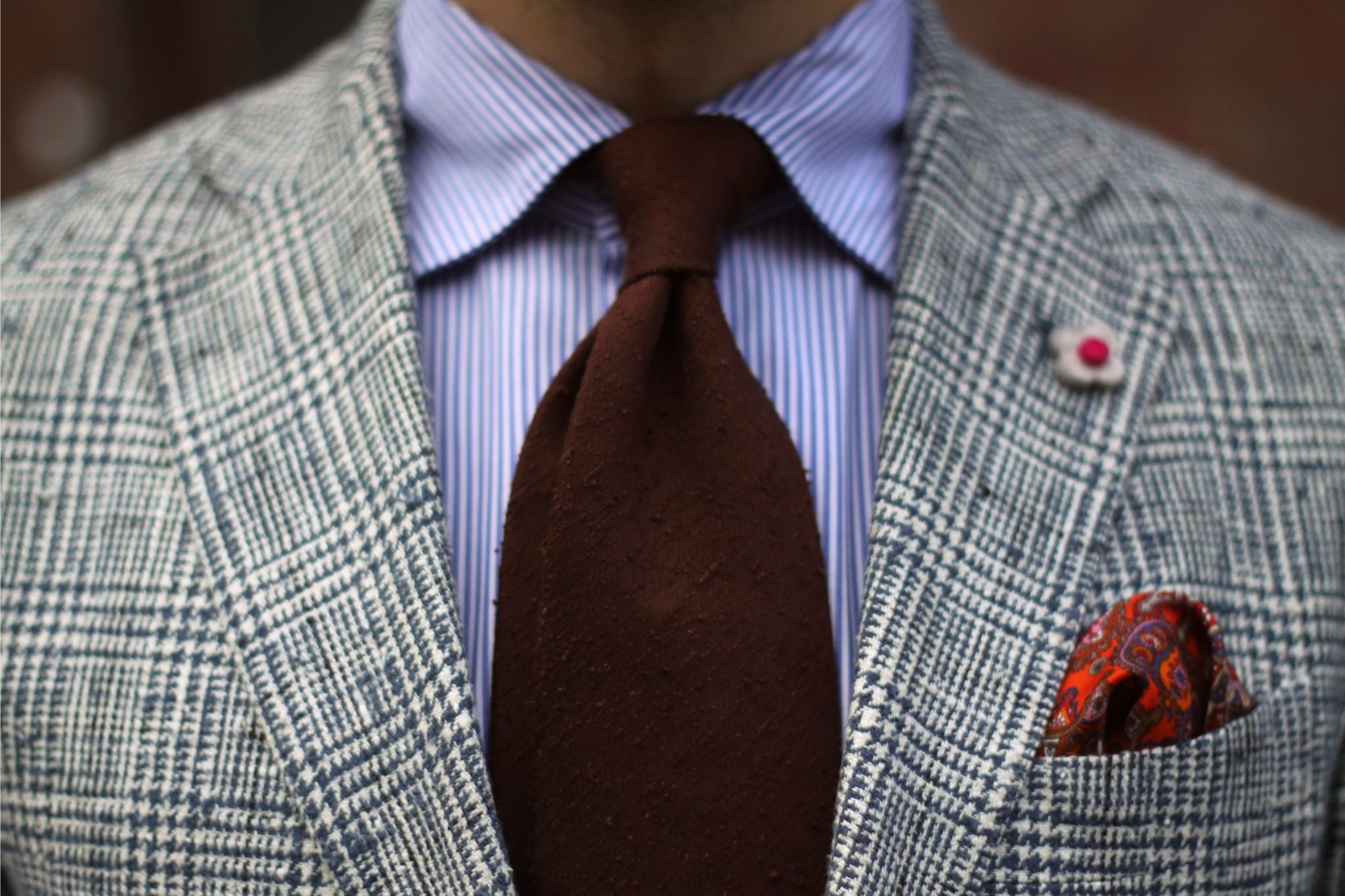Raw silk ties are among the most versatile pieces of neck wear there is. In case you are looking for an option that can easily be dressed up or down, shantung silk tie is a preferable option.
In this post I take a look of an outfit featuring a solid brown shantung silk tie. An option that was one of three we wanted to have in the first DLA-selection as well. The tie in this post is handmade in Italy by Viola Milano that I got back in the days. I have chosen to wear it here with an outfit I feel it is most suitable to wear with. 
The rich texture of shantung tie brings just the right kind of contrast to otherwise basic and simple outfits. And it is a perfect option to balance office and off€“duty looks.
Shantung silk tie in a nutshell
Shantung silk - one version of raw silk - is a dupioni silk. That means the silk yarns are made from the cocoon of two silk worms that have nested together. If you did not know, all Chinese silk is produced by silk worms. The type of silk is named after the part of China from where it originates, Shantung or Shandong. The province is located on the east coast of the North China Plain.
The most notable feature of shantung silk ties is the durable, textured feel. This is a result of the manufacturing process. The dupioni silk is spun, but the double strands of the yarns are not separated. Traditionally Shantung silk has been woven manually from uneven yarns, which then results in a soft and variably textured silk. Many shantung silk ties are soft but slightly crisp. They feature many little knots or slubs on the surface of the cloth making it look uneven.
Due to the rough surface shantung silk ties are particularly suitable as part of more relaxed but still dressed up style. The texture of the silk is a nice way to bring a little contrast to otherwise basic and simple outfit. It works pleasantly as well with hard and softly tailored jackets.
While the knit ties are a preferable option to balance between office and off duty looks, shantung is another great fabric option for that. While often under the radar, it fits the purpose perfectly. 


How to wear shantung silk tie
Most of times shantung is referred as a suitable choice for fall and winter wear. Still I dare to say you can wear these ties can easily around the year. Thanks to the slubby and rough surface you can combine shantung ties with more heavier tweed or flannel fabrics during the colder months. But you can also wear them with linen or smooth and lightweight wools during spring and summer.
As the material itself is quite phenomenal and likely to attract attention my advice is to opt for simple and plain pieces in earthy tones. Shades of brown, forest green, dark blue or even seasonal colors such as burnt orange or deep purple are options I recommend. 
Shantung for formal occasions
Raw silk ties are sometimes referred as an option for men whose knowledge of style is in general above the average. Decent quality shantung silk ties are not the most easiest to find. Still many consider them to be a stylish and distinctive choice. I personally see no reason why a shantung silk tie could not be worn even with a suit. In fact shantung fabric is widely used in wedding gowns as it drapes well, is crease resistant and has a natural lustre. So if you're bride is wearing shantung silk in her dress, it might be a nice detail to wear a tie made of the shantung for your wedding.
Even though for most formal occasions - such as funerals and strict business meetings - I would go with grenadine or smooth silk pieces. Raw silk and shantung are options worth to consider. Take a mid-grey flannel suit, light blue button-up and dark blue shantung tie - and you're set.
Shantung for business casual
In my opinion - business casual is probably the most suitable "environment" for raw silk ties. The kind of unique - slubby texture of the fabric and raised flecks makes it a perfect intermediary between the informality of a knit tie and the dressy look of a polished silk or wool pieces. So in case you want to dress down your formal office look or dress up a more casual one, shantung silk is a good choice. It will also make you stand out from the rest of the crowd.
Shantung for Casual
You may ask how casual could an outfit or occasion be - if you anyway are about to wear a tie. During the last couple of years I have dressed down my personal style to be more casual. But I am still quite fond of wearing ties, even though the situation would not really require one.
Shantung ties can be easily combined with casual outfits. For example, take some nice denim, a shawl collar cardigan and button-down shirt. Finalize the outfit with a plain shantung tie and you are set for a casual dinner or just for a relaxed stroll around town.
Sum-up - how would I wear a shantung silk tie
As mentioned, the tie here is a shantung silk tie in solid dark brown. It is a classic 3-fold, untipped and comes with handrolled edges. It is actually quite normal that shantung ties are made with minimal amount lining and no tipping. The material itself is so strong and sturdy that any additional reinforcement could make it too heavy.
On Saturday we visited Tallinn to have lunch. For the trip I decided to wear something that could probably fall between casual and "business casual". I chose a patterned wool-silk sport coat made by Lardini and striped cotton button-up shirt from Mastai Ferretti. Dark blue denim slacks from Finealta and racing green suede loafers by Carmina. Actually I could easily wear the upper half to any work-related meeting. In that case I would just change the pants to something a little more dressed-up such as flannel slacks. And I would wear some laced-up shoes. In my book - this is an optimal place for this kind of a tie. Not too formal but still dressed up and chic.





Leave a comment